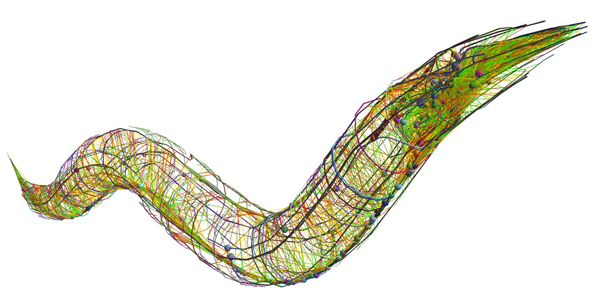Perlara’s worm team recently attended two C. elegans neuroscience conferences – CE Neuro 2018 & CE Aging 2018 – both held at the University of Wisconsin, Madison. This post recaps Zach and my time at the CE Neuro 2018 conference, which focused on neuronal development, synaptic function & behavior. The CE Aging meeting was recapped in a separate post.
Zach Parton:
My first introduction to a worm conference came when I recently had the chance to attend the Neuroscience topic meeting for C. elegans at the University of Wisconsin Madison.
I quickly found the dovetail in topics between neuroscience conferences, which I had attended before, and worm conferences about neuroscience. I had mostly focused on human neuroscience, so while there was a similarity in the kinds of things being worked on – tracking neuronal firing during movement, measuring strengths of reaction to stimuli – it was done at a different level, and it was a huge contrast. Whereas human neuroscience talks about populations of neurons, worm neuroscientists name the neuron(s).
The first talk by Manuel Zimmer dealt with how one could quantify stereotyped behavior, and with what regularity it occurred. He was essentially looking for high level patterns, down to the neuronal level, of seemingly stochastic behaviors. A heated debate ensued over his use of the term “oscillation” and ensured that I was excited for good reason.
Every speaker was knowledgeable and thorough. I particularly enjoyed learning about WurmPaint by a group from the Georgia Institute of Technology. It’s an open-source application put together to help use human annotation of worm positions to help build databases to run simulations and train automated annotation programs.
I was also fascinated by an idea proposed by Navin Pokala: turning selective neurons on and off with chemical agents by genetically inserting channels sensitive to an otherwise unreactive agent.
Finally, it was a particular pleasure to see a piece of software which I had played around with a bit, not only be mentioned, but put to the coolest of uses. The Tierpsy Tracker was used in research presented by Siyu Serena Ding, from the Brown Lab at Imperial College London, to model population level behavioral dynamics in C. elegans aggregation behavior, with an eye toward testing simulation of genetic differences.
Zach presenting his poster on finding a PMM2 modifier screen
On day 3, it was my turn to talk about our work. My poster on PMM-2 disease screening was well received, and I had the opportunity to talk about it with Carl Johnson, founder of the first commercial C. elegans drug discovery venture, NemaPharm! That was especially gratifying.
Finally, Madison was lovely, especially in the summer heat. The nights were warm and the beer cold and it was, all in all, a heck of a time!
Sangeetha Iyer:
I always love worm meetings, because it gives me a chance to reconnect with all of my old friends, and learn about new developments! As always, there were some amazing new discoveries, noteworthy among them being the discovery of ion channels in the worm that – surprise, surprise – fire with action potentials!
I am always on the lookout for nematode models of human disease, and forays into therapeutic discovery using nematodes. To this end, the following three talks caught my eye:
Luisa Scott, University of Texas at Austin: (Disclaimer: This talk came from a dear colleague at my former postdoctoral lab at UT Austin’s Pierce lab, so I may have been extra excited about it. That said, it is a really cool story that took about 5 years to unfold!) Luisa Scott spoke about modeling alcohol withdrawal behaviors in nematodes using an alcohol preference assay. She also described the discovery of a sigma2 receptor agonist that reduced alcohol withdrawal behavior in nematodes, and was found to reduce alcohol drinking behavior in mice!
Sandra Encalada, The Scripps Research Institute: There is a need to understand the proteotoxic mechanism of neuronal loss in diseases like amyloidosis, transthyretin (ATTR), because existing therapeutic options work only in a subset of patients. A nematode model of ATTR displays numerous similarities to human ATTR pathology, including loss of pain sensation, which can be studied using a heat sensing assay. Cellular characterization showed that numerous sensory neurons display branching defects in ATTR mutants. Furthermore, coelomocytes (the scavenging organelles) in worms play a role in regulating proteotoxic aggregates, because their ablation resulted in exacerbation of the ATTR sensory defects in nematodes.
Rebecca Taylor, Medical Research Council, Laboratory of Molecular Biology, UK: Neurons coordinate aging through stress responses. Activation of some canonical stress response genes such as xbp-1 triggers the push towards homeostasis. Neuronal and intestinal xbp-1 expression coordinate to protect against a variety of proteoteoxicities by impinging on lysosomal function. Our understanding of how this inter tissue interaction takes place is still evolving.

The views from the conference at University of Wisconsin, Madison
Last but not the least, a recap of events is never complete without a shout out to all the cool devices seen at the C. elegans meetings!
Shawn Lockery of University of Oregon, Eugene, and CTO of NemaMetrix, introduced the Poker Chip, a microfluidic chip that allows for easy microinjection of worms with existing technology. I was super excited to see this and signed up immediately to test it!
Newormics LLC, a microfluidics platform company by Adela Ben-Yakar and team, unveiled their microfluidic chips for easy immobilization and imaging of up to 5000 worms, proving yet again that you are only limited by your imagination! We already beta tested their dual chip that can immobilize up to 80 worms in tandem, across two sets of microfluidic channels, and it was awesome!
Read the CE Aging 2018 recap, or catch up on our latest nematode blog posts about modeling Gaucher Disease, and developing an NGLY1 worm screen.
Image courtesy of C. elegans Meetings




